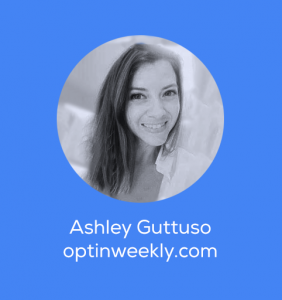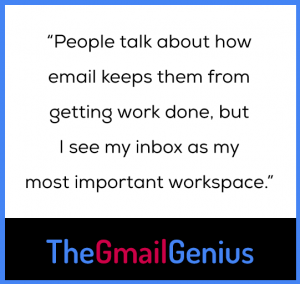How I Email: Ashley Guttuso, Director of Marketing, Simple Focus Software
Email is a non-negotiable part of everyday life. For some, it’s an unruly time suck, but enlightened email users have systems to ensure they’re not a slave to the inbox. We’re asking smart thinkers to give us a peek inside their inboxes, share tips, ideas, gripes, and everything in between.
Ashley Guttuso leads marketing for Simple Focus Software, a usability and design company that has created several digital products, including newsletter platform Curated. Ashley was kind enough to share some of her best tips for email newsletters and also explained why she’s “an email-in-the-morning-over-coffee kind of woman.”
 What’s your daily approach to email?
What’s your daily approach to email?
My background is in journalism, partly because I love research and partly because I love storytelling. I was that student who checked out 30 library books on one topic when I had a research project. I enjoy the process of immersing myself in something and finding what I think of as “kernels of goodness.”
Because I’m currently delving into what makes a good email newsletter, my email inbox is less of an actionable list of to-dos (that’s for project management software) or random back and forths (that’s for Slack) and more of a research library. I keep things sorted, but not overly so, and I try to process based on priority, delete anything that I can, and star what deserves my future attention. Action items get sent to a to-do list. Meeting invites get a quick response. Interesting inquiries get starred. Emails I want to study get pushed to a morning time block when I intentionally spend quality time with them. From there, I send anything I know should go in my newsletter to a collected links queue to be ready for me when I’m in creation mode. I also add ideas sparked by email to a corresponding Notion page.
I’m an email-in-the-morning-over-coffee kind of woman. I feel like it’s the modern equivalent of perusing the Sunday edition of the New York Times. I try to start with the most recent unopened and work my way through everything I’ve not processed. I’ll check back throughout the day, respond to any action items, but save the next long session of research/email study for the next morning. It’s habitual and a relaxing way to start my work day.
I have absolutely no problem with a cluttered inbox. If it’s down to zero, I’m not being me.
What are your favorite email tools?
Call me old fashioned, but I don’t really use any tools or secrets to alter my email experience. I’m quick to unsubscribe from emails that aren’t providing some value, but I intentionally subscribe to people and brands I respect and want to study. I think people like to talk about how much email they have and how it’s keeping them from getting work done, but I see my inbox as my most important workspace.
Email delivers ideas, enables 1:1 communication, and links me to content I want to curate and share with my readers. I consider it worthwhile to spend time there. If your job involves sending emails to an audience to establish and build trust, the best way to know what works is to be an active participant in your own inbox, which allows you to study your own behavior, too.
So maybe my tip is don’t be afraid to get lost in your email if it’s an activity that fuels your decisions.
My only “tool” is using the secret email address to forward links to my newsletter software.
Email newsletters are having a moment. For marketers and others who are leveraging the power of newsletters, what are some of the things you see working right now?
After spending some time studying email newsletters, I’ve established a list of reasons I’ll open or unsubscribe.
The reasons I will open your email newsletter:
✅ You always provide information that helps me become better at my job.
✅ I really like the stories you tell and the way you tell them. I feel like I know you / your brand.
✅ You’ve earned my trust. You have a track record of not pushing me to buy anything in your newsletter. If you have something to sell, it feels secondary to the content I’m consuming.
The reasons I will not open your email newsletter:
❌ It’s clear the motive of your newsletter is to sell me something.
❌ Your business tips haven’t helped me.
❌ Your stories are boring.
One common strategy our most successful newsletter creators using Curated do is start with an intro section that includes some personal commentary. This is best done a little informally to establish a relationship between sender and reader) and to have the email be sent from them with their name. Dave Verwer of iOSDevWeekly.com, Bethanie Dennis of TheWeeklyPR.com, and Dawid Dylowicz of SoftwareTestingWeekly.com are all great examples. I’m trying to channel that in my OptInWeekly.com prologue.
Another successful trend I’m seeing is making your archives available and searchable. Newsletters can live on as great resources if you have a publication site that houses the archived content and gives news readers the opportunity to look back through what you’ve written.
 Share a story about a particularly memorable or life-changing email.
Share a story about a particularly memorable or life-changing email.
Here’s one that might be timely for people looking to land job interviews in a highly competitive market: When there are hundreds of people applying for a job, getting noticed by a recruiter is hard.
I really wanted an interview one time, but I’d not heard anything for a week after submitting my application, so I figured out the email structure for the company and directly emailed the CMO. And it wasn’t a generic “Hi there, I’d like to be considered” email. It was highly researched and as personal as I could make it without being weird.
I used a creative subject line: 📌 Notice: Your ABM solution is arriving soon.
I provided a short intro and 10 interesting facts about myself in list format. They all included what, from researching him, I surmised were shared life experiences and ways I’d solved problems without saying “I’m good at solving these types of problems.” For instance, I included that I was part of the class of 2000, knowing he was also.
I closed with a request to be interviewed.
He didn’t respond directly, but I heard from a recruiter 30 minutes after I sent the email and went through two rounds of interviews.
Here’s the kicker: I didn’t get the job. But I did figure out how to use email to get that interview. Email can be incredibly powerful that way.